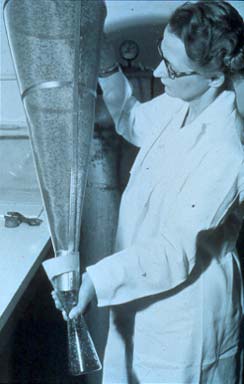 |
Enforcement of the new law came swiftly. Within two months
of the passage of the act, the FDA began to identify drugs such
as the sulfas that simply could not be labeled for safe use
directly by the patient--they would require a prescription from
a physician. The ensuing debate by the FDA, industry, and health
practitioners over what constituted a prescription and an over-the-counter
drug was resolved in the Durham-Humphrey Amendment of 1951.
From the 1940s to the 1960s, the abuse of amphetamines and barbiturates
required more regulatory effort by FDA than all other drug problems
combined. Furthermore, the new law ushered in a flood of new
drugs applications, over 6,000 in the first nine years, and
13,000 by 1962.
 |
Illegal sales of amphetamines
and barbiturates occupied more regulatory concern at FDA
than all other drug problems combined from the 1940s to
the 1960s. Interdiction in some venues required undercover
tactics, as indicated here by these two inspectors posing
as truck drivers. |
A new drug law in that year, the Kefauver-Harris Amendments,
derived in large part from hearings held by Senator Estes Kefauver.
As with the 1938 act, a therapeutic disaster compelled passage
of the new law; in this case the disaster was narrowly averted.
Thalidomide, a sedative that was never approved in this country,
produced thousands of grossly deformed newborns outside of the
United States. The new law mandated efficacy as well as safety
before a drug could be marketed, required FDA to assess the
efficacy of all drugs introduced since 1938, instituted stricter
agency control over drug trials (including a requirement that
patients involved must give their informed consent), transferred
from the Federal Trade Commission to the FDA regulation of prescription
drug advertising, established good manufacturing practices by
the drug industry, and granted the FDA greater powers to access
company production and control records to verify those practices.
Three years later Congress gave the FDA enhanced control over
amphetamines, barbiturates, hallucinogens, and other drugs of
considerable abuse potential in the Drug Abuse Control Amendments
of 1965. That function was consolidated with similar responsibilities
in 1968 under an organization that gave rise to the Drug Enforcement
Administration.
 The
first food standards to be issued under the 1938 act were for
canned tomato products; by the 1960s about half of the food
supply was subject to a standard. As food technology changed
and the number of possible ingredients--including fortifying
nutrients--grew, the agency developed recipe standards for foods,
lists of ingredients that could lawfully be included in a product.
A food that varied from the recipe would have to be labeled
an imitation. The
first food standards to be issued under the 1938 act were for
canned tomato products; by the 1960s about half of the food
supply was subject to a standard. As food technology changed
and the number of possible ingredients--including fortifying
nutrients--grew, the agency developed recipe standards for foods,
lists of ingredients that could lawfully be included in a product.
A food that varied from the recipe would have to be labeled
an imitation.
Following hearings in the early 1950s under Representative
James Delaney, a series of laws addressing pesticide residues
(1954), food additives (1958), and color additives (1960) gave
the FDA much tighter control over the growing list of chemicals
entering the food supply, putting the onus on manufacturers
to establish their safety. Responding to the proliferation of
pesticides after World War II, FDA pharmacologists developed
the fly bioassay (pictured at right), a rapid and sensitive
test that could be used in conjunction with chromatographic
procedures to screen a variety of chemicals. While tolerances
could be established for many chemicals, a provision of the
1958 law, the Delaney Clause, banned any carcinogenic additive.
FDA pursued numerous cases of food misbranding in the 1950s
and 1960s, most deriving from false nutritional claims and unscientific
enrichment, with mixed success in the courts. In 1973, following
hearings the agency convened to address the vitamin fortification
of foods and the claims made for dietary supplements, the FDA
issued regulations for special dietary foods, including vitamins
and minerals. The public response to these regulations helped
lead Congress in 1976 to prohibit the FDA from controlling the
potency of dietary supplements, although the agency maintained
authority to regulate enriched foods.
Next: Regulating Cosmetics, Devices,
and Veterinary Medicine After 1938
|
 |
 |
|
|
 |
 |